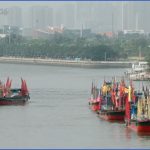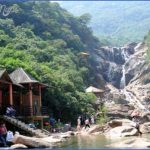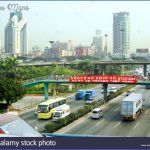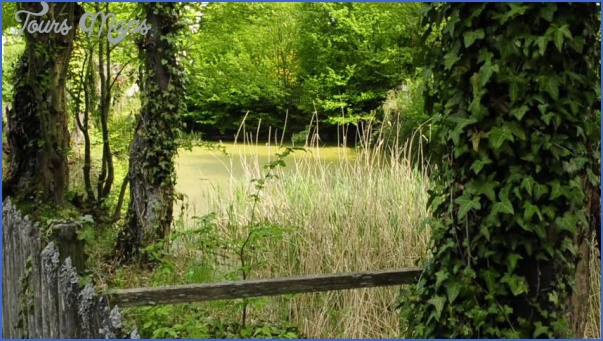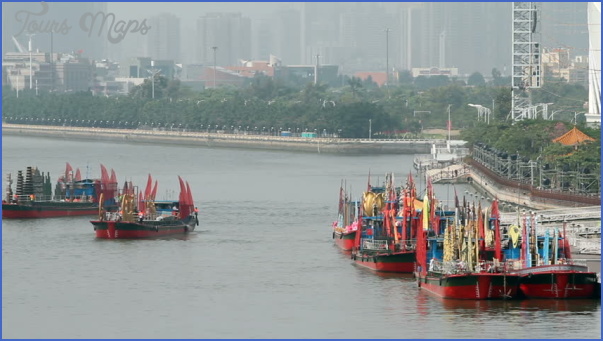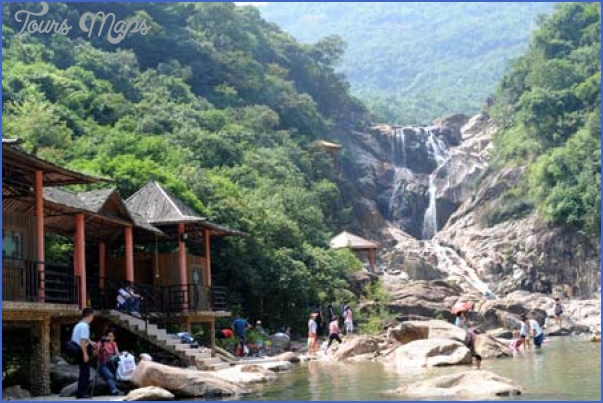Altitude 5m/16ft. Area: 1345sq.km/519sq. miles Population: 3,220,000 (conurbation 5,870,000)
Canton lies in a fertile plain in the centre of the south Chinese province of Guangdong, in the delta of the Zhujiang, at 113°14’E and 23°12’N.
Canton can be reached from Hong Kong by air, rail, ferry or bus and from Beijing by rail or air. There are also regular flights to various other Chinese cities such as Shanghai (21/2hrs), Tianjin (3hrs), Shijiazhuang, Wuhan, Changzhou, Qinhuangdao and Hohhot.
Canton is not only an economic, but also a cultural centre. The Sun-Yat-sen University (Zhongshan Daxue) has an importance extending well beyond the immediate area of Canton, while in the city’s opera houses the Chinese opera tradition continues to be nurtured.
Cantonese cooking, in which seafood plays a crucial part, is also famous.
An important Cantonese legend tells the story of howfive gods came down to earth on goats and gave the inhabitants five ears of corn in order to protect them from famine.
The city of Canton, which was originally called Fanyu, has a history dating back over 2000 years. In 214 b.c. Emperor Qin Shi Huangdi nominated it capital of the administrative area of Nanhai (Southern Sea) in recognition of its growing importance as a river and sea port. In a.d. 226 it was renamed Guangzhou. From the time ofthe Tang dynasty (618-907) onwards Canton developed into a centre of foreign trade and as a result a large Islamic community grew up here. Under the Song dynasty (960-1279) the city enjoyed a golden period. In 1517 the Portuguese landed here, followed by the Spanish, Dutch, British and French. Over the years the harbour became larger and larger and in 1684 the East India Company moved its headquarters here in order to be able to have better control of its trade in. the opium which it was bringing over from India. In 1839 the Imperial High Commissioner Lin Zexu had 1185 tons of opium destroyed in Humen, a small village near Canton, and in so doing triggered off the opium wars between Britain and China. In 1841 the city offered stubborn resistance to the attacking English troops, with the peasants of Sanyuanli (today a suburb of Canton) particularly distinguishing themselves. In the Treaty of Nanking (1842) the city was forced to open its doors to foreign trade and in 1858 the island of Shamian became a foreign concessionary area. This contact with foreigners was destined to imbue the Cantonese from very early on with nationalistic sentiments, a readiness for reform and revolutionary ideas. At the beginning of the 20th c. Sun Yat-sen started numerous uprisings against the Qing government.
In 1918 the city began to be modernised, with wide streets being laid out, countless shacks torn down, canals filled in and the city walls taken down. The year 1924 saw the founding ofthe Whampoa military academy where Zhou Enlai studied. In the period following, Zhou, Guo Moruo and Mao Zedong taught at the local institute ofthe peasants’ movement. After the rupture in relations between the Communists and the Guomindang, more than 5000 of the former lost their lives at the hands of Guomindang troops during a workers’ revolt in 1927. In 1949 Canton fell to the Communist regime.
In the 1950s Canton became an important centre for industry (steel, chemicals, textiles and foodstuffs) and foreign trade, a development which was helped by its proximity to Hong Kong. Since 1957 the famous Canton Fair has taken place twice a year.
The temple site, situated in Chaoyang Beilu Street in the old part of the city, was built in a.d. 537 on the orders ofthe provincial governor ofthe time, Xiao Yu, in order to house one of Buddha’s bones. It is named after the six banyan trees which formerly stood in the courtyard and to which the poet Su Dongpo dedicated a piece of writing.
Hall ofthe In the Hall ofthe Sixth Patriarch the visitor is able to admire a bronze statue
Sixth Patriarch 0f the monk Huineng, the founder of the Southern School of Chan (Zen)
(Liuzu Tang) Buddhism. The statue was cast in the Song period (960-1279).
Capital of Guangdong Province Photo Gallery
Maybe You Like Them Too
- The Best Cities To Visit in The World
- World’s 10 Best Places To Visit
- Coolest Countries in the World to Visit
- Travel to Santorini, Greece
- Map of Barbados – Holiday in Barbados



